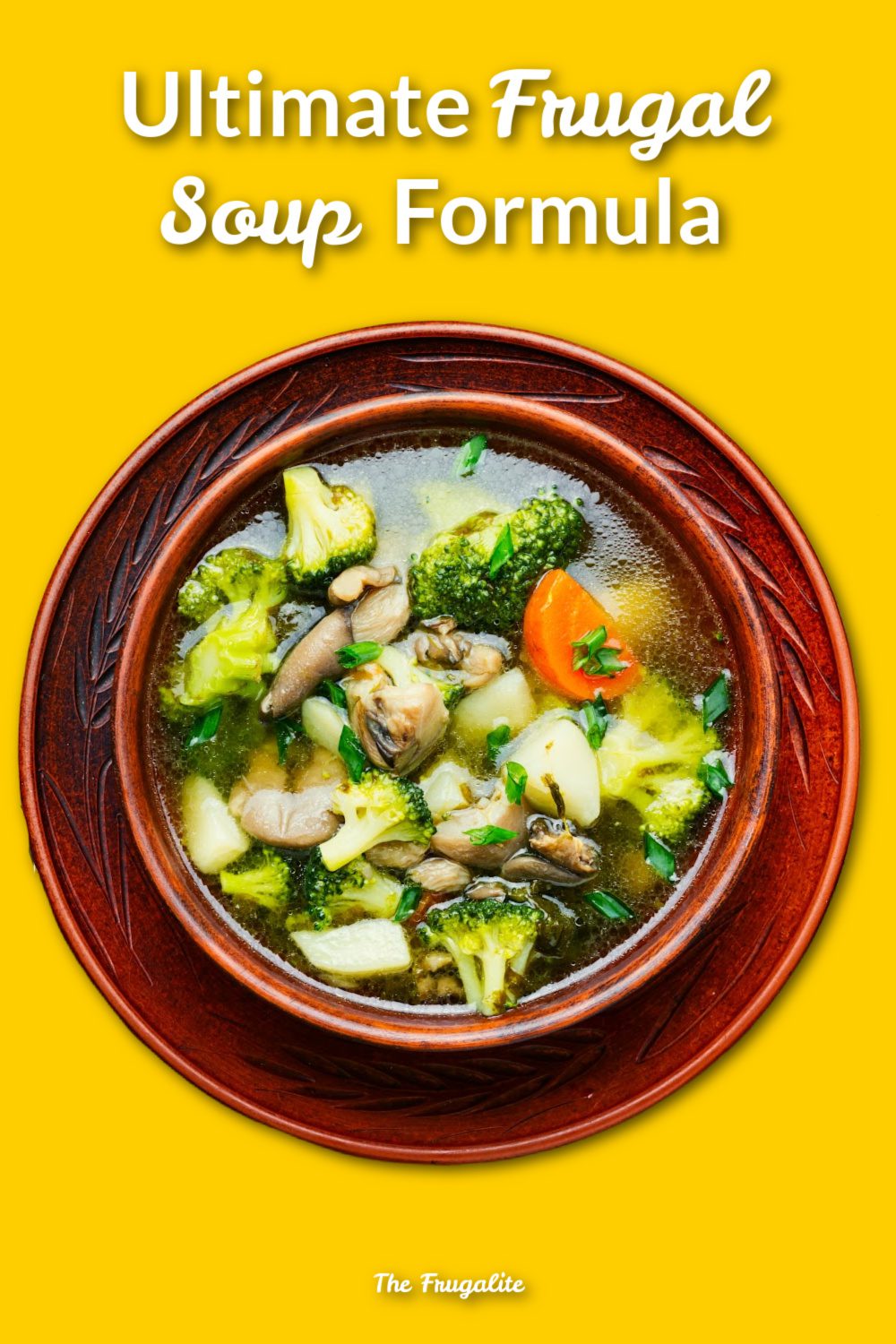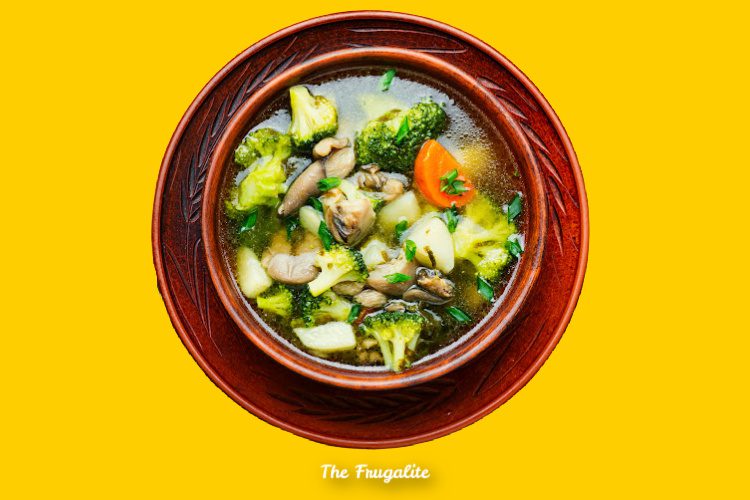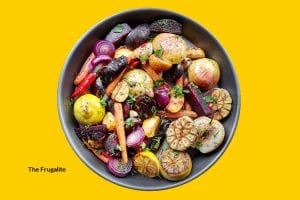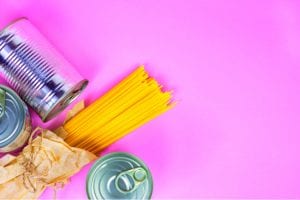(Psst: The FTC wants me to remind you that this website contains affiliate links. That means if you make a purchase from a link you click on, I might receive a small commission. This does not increase the price you’ll pay for that item nor does it decrease the awesomeness of the item. ~ Daisy)
By the author of The Ultimate Guide to Frugal Living and What to Eat When You’re Broke
One of the best ways to stretch a meal is by taking a small amount of food and creating the ultimate frugal soup! You don’t even really need specific ingredients for this. You can use the guidelines in my Ultimate Frugal Soup recipe and assemble that strange mish-mash in your fridge into a delicious and satisfying meal.
I’ve shared my recipe for Universal Casseroles and here you can find my universal jam recipe.
Not only is soup thrifty in good times, but it can make things much better during bad times. In one article, Selco explained how, during the Balkan War, the women often made soup from whatever they could find to keep people fed when few supplies were available.
Components of Ultimate Frugal Soup
You need liquid, protein, produce, starches, and seasoning for a nicely balanced bowl of soup. (Below, I’ll talk more about each of these.)
The nice thing about Ultimate Frugal Soup, however, is that you can use what you have on hand. The only absolute necessities are liquid (because, um…it’s soup) and at least one other ingredient.
Ultimate Frugal Soup is a great way to use up leftovers and combine the things you have on hand into something tasty and filling. If you add bread, you can stretch it even further.
I often use the crockpot for Ultimate Frugal Soup. At night, when I’m putting away leftovers, I like to combine complementary items into the crock, put the lid on, and pop it into the fridge. A couple of days later, when I have enough veggies and meat in the crock, I will add my liquid and cook it on low all day. It’s so nice to arrive home to the delicious smell of soup.
Liquid
The sky is the limit when it comes to the liquid you’re going to use for your soup. Think about your other ingredients when choosing a liquid and be sure that it will combine nicely. Whatever liquid you use, you can go with a minimum of a 50:50 ratio of liquid and water to make a less expensive yet still rich-tasting soup.
Here are some ideas for liquids you can use.
- Tomato juice
- Crushed tomatoes
- Broth (beef, chicken, vegetable, etc)
- Vegetable puree
If you don’t have any of these things on hand, you can start your liquid the night before. Simply put 10 cups of water in your crockpot and add onions, garlic, celery, and/or a whole carrot. Season it with a little bit of salt. Cook it on low overnight and you’ll have a tasty golden broth to which you can add your other ingredients the next day.
Another choice is to use beef, vegetable, or chicken bouillon on water. I don’t like to consume MSG, so I usually go with an organic boullion or one that is MSG and gluten-free. You can stock up on ones like these so that you have them on hand to make soup on a dime.
I add the liquid last. I put in all the other ingredients and then top off my crockpot with my chosen liquid and water.
A Few Options
If you want a creamy soup, cook it with a broth base. Then about two hours before serving time if you are slow-cooking and 15 minutes before if you are stovetop cooking, you can make it creamy. You have a few different options.
- Add a cup of milk or cream. (For a non-dairy option, cashew milk is a nice addition.)
- Puree a large cooked potato or a can of white beans and stir in the puree.
- Add one cup of sour cream or plain Greek yogurt if it’s something that will go with the flavor of the soup.
- Scoop out a cup of the soup liquid into a bowl and then thicken it with cornstarch, flour, or arrowroot starch. Get all the lumps out in the bowl, then pour it back into the soup and stir well.
Liquid is the base of your soup and your choices are really important to the end result.
Protein
If you want to make a meal that will stick to your ribs, you need protein in your soup. I often use leftovers for my protein. Here are some ideas for protein-rich additions for Universal Soup.
- Beef
- Chicken
- Pork
- Sausage
- Ham
- Pinto beans
- Kidney beans
- Navy beans
- Lentils
If you are using meat, it can be a variety of different textures: diced, ground, or shredded. If you are using legumes in your soup, you will either need to use canned beans/peas or presoak them the day before.
I like to use 1/2 a cup of protein per person. But if the situation is not ideal and you are cobbling together leftovers, just use what you have.
Produce
Soup is a great way to do two things: use up random leftover veggies and get more produce into your family. Don’t worry if your leftover vegetables have butter or other seasonings on them – this will just add to the flavor of the soup.
Depending on how you are cooking your soup (quickly on the stovetop or slowly in the crockpot), this will affect your decision on what kind of produce to add and when to add it. If you are doing a quick stovetop soup, add everything at once. If you are slowly cooking your soup, follow these guidelines:
- Leftover vegetables: Add them in the last hour of cooking. If you put them in all day, they’ll be mushy and unpleasant at serving time.
- Canned vegetables: Add them when you start the soup and use the liquid they’re canned in for your base liquid.
- Frozen vegetables: Add them in the last 2 hours of cooking – they’re pre-cooked and don’t need much time.
- Fresh vegetables: Starchy vegetables like turnips or carrots take longer to cook. You should dice them into small pieces to make certain they’ll be cooked thoroughly and put them in at the beginning of your cooking time. Other more delicate vegetables like peas, corn, summer squash, broccoli, and green beans only need a few minutes so I suggest putting them into the crockpot during the last half hour.
You can use whatever produce you have kicking around. I often put together a nice soup with one can each of peas and carrots, corn, green beans, potatoes, and diced tomatoes. I use all the juices and then add ground beef (raw if you are crock-potting all day, cooked if you are doing a fast stovetop soup.) This is a soup so easy that even a non-cook can make it.
Starches
Starches extend your soup and turns it into a filling meal. Here are some great starches along with when to put them in. With most starches (other than potatoes) I prefer to cook them separately and stir them in toward the end. They soak up a lot of liquid, particularly rice. But worst case scenario, if it is cooked in the crockpot all day you will end up with something more casserole-y than soup-y. Aside from pasta – definitely do not add it at the beginning of the day and hope for the best. You will not get “the best.”
Potatoes – Is it even soup if there are no potatoes? They should be put in at the beginning regardless of whether you are cooking in a crockpot or cooking on the stovetop. Dice them into small, bite-sized pieces.
Pasta – Don’t put the pasta in too early or you will have a bowl of mush. Look at the package and double the time required. So if the package says the pasta will take 10 minutes to cook, put it in about 20 minutes before serving time. Be sure to taste a piece to make sure that it is thoroughly cooked.
Rice – I often cook rice in a separate container because it soaks up so much cooking liquid. I really think that is the best way to go about adding rice to soup. Add your cooked rice about half an hour before serving time to allow it to absorb flavors without absorbing all your broth.
Barley – My favorite barley is pearl barley. Before cooking barley, you should rinse it and pick through like you would with beans. Add the barley at the beginning of cooking time and go with about 2/3 of a cup – it gets much bigger when it cooks. Watch your liquid to see if you need to add more about an hour before serving time. If you’re cooking it on the stovetop, barley needs about 45 minutes.
Bulgur – This is some yummy stuff derived from wheat berries (so beware if you are gluten-free) and a lot of vegetarian recipes use as a substitute for ground beef due to the slightly similar texture. Some prep work is needed for bulgur. Put it in a large, heatproof bowl and pour boiling water over it. Allow it to soak for about 15 minutes, then drain it before adding it to your recipe. Bulgur can go into the crockpot in the morning or takes about 25 minutes on the stovetop.
Farro – Farro should be rinsed before adding it to your soup. One cup of farro will be sufficient for an entire pot. Put it in at the beginning of your cooking time and watch to see if you need to add more liquid.
There are all sorts of other grains you can add. Consider millet, sorghum, amaranth, freekeh, wild rice…so many different grains. If you are using something unfamiliar, I urge you to cook it separately until you learn the ins-and-outs of that particular grain. If you can’t tolerate gluten, don’t be afraid to sub in a gluten-free grain for your recipe.
Seasoning
Soup can be seasoned any way you want but below you’ll find a few ideas. The measurements are up to you – some folks only want mild flavor while others want intense flavor, and it also depends how much soup you’re making. So I’m listing off spices and it’s up to you to assemble it how you want. Add salt and pepper to taste on all these.
- Tomato-based soup: Basil, oregano, garlic, onion, parsley, marjoram, and thyme. I loathe rosemary but if you’re a fan, it would work in these kinds of soups, too.
- Mexican or Southwestern: Chili powder, cumin, onion, garlic, smoked paprika.
- Chicken broth-based soup: Sage, oregano, garlic, onion, parsley, thyme, and rosemary if you like it.
- Creamy soup: Thyme and just a teeny tiny dash of nutmeg
- Beef broth-based soup: Thyme, paprika, garlic, onion, oregano, and parsley
Obviously, use what you like and skip what you don’t. You will never see rosemary in one of my soups, but if you love it, go for it! A lot of people have particular spices they really dislike. For example, some folks think that cilantro tastes like soap while other people absolutely adore it. (This is genetic, interestingly enough.) Different spices can really help the same-old, same-old taste brand new, so don’t be afraid to experiment.
So…what’s for dinner?
Are you making soup? I am. I’m making a ground beef and vegetable soup in a tomato base with the blend recommended above. Are you planning to try out the Ultimate Frugal Soup recipe? What are your favorite soup concoctions? Do you use soup to stretch your groceries? Share your thoughts about soup in the comments below.
About Daisy
Daisy Luther is a coffee-swigging, adventure-seeking, globe-trotting blogger. She is the founder and publisher of three websites. 1) The Organic Prepper, which is about current events, preparedness, self-reliance, and the pursuit of liberty; 2) The Frugalite, a website with thrifty tips and solutions to help people get a handle on their personal finances without feeling deprived; and 3) PreppersDailyNews.com, an aggregate site where you can find links to all the most important news for those who wish to be prepared. Her work is widely republished across alternative media and she has appeared in many interviews.
Daisy is the best-selling author of 5 traditionally published books, 12 self-published books, and runs a small digital publishing company with PDF guides, printables, and courses at SelfRelianceand Survival.com You can find her on Facebook, Pinterest, Gab, MeWe, Parler, Instagram, and Twitter.












10 thoughts on “The Ultimate Frugal Soup Formula”
LOL moment…remembering the first time I made beef and barley soup and it was like eating glue it was so thick!
I do the same, call it kitchen sink soup, because you put in everything BUT the kitchen sink!
Barley soaks up SO MUCH LIQUID!!!! I’ve also done this with a dense pasta before when making pasta Fagioli 🙂
About 1930, the soviet regime in Russia uprooted about 300,000 peasant farmers and exiled them in Kazakhstan. They dumped the exiles in the middle of a treeless plain and their job was to mine coal. There was no provision for the exiles and many of them starved to death and the numbers were reduced by about 150,000 in the first year. I read in the book “Elder Sebastian of Optina” that the reduced to the women making soup out of grass; they lived in holes dug out of the ground with plank as a roof to cover them to partially offset the intense cold. Grass soup doesn’t sound very good to me.
Soups and chilis are the absolute best. I’m trying to eat more plant-based meals so when restaurants offer their salty “10 vegetable soup,” I am motivated to come home and make my own healthy 12 vegetable soup! Anything they can do, I can do BETTER! Everybody, and I mean EVERYBODY should learn to cook. I started with the Betty Crocker cookbook. Cooking is more cost effective, healthier, and builds tremendous confidence. I’ve always been able to make the most delicious meals on a shoestring budget. Embrace cooking.
If you don’t want to heat up the house, a fun alternative is cold soup.
I just made some “leftover soup” today out of random things that had either gone mushy in the ridge or were about to go bad, but hadn’t quite yet. Basically the way is to take whatever soft veggies are lying around and puree them in the blender or a food processor, season to taste, then add any extras you want.
For example, today’s soup was a couple handfuls of wilted cilantro, some pea shoots that had been frozen then thawed so the texture was off, a couple overripe tomatoes, some green onions that were partially dried, and half a can of tomato sauce left over from the previous night’s pizza making. I added water, dill weed, salt, and some soy sauce that I’d been marinating hard boiled eggs in. Turned out pretty good!
I’ve also made this type of soup with frozen spinach, broccoli, cauliflower, and chicken broth powder.
You can add something like mushrooms, chickpeas, mushroom chunks, etc for texture, protein, etc. How much you cook it depends on taste and how powerful your blender is.
Other “ingredients” we’ve used is small amounts of left over au jus, ‘cream of” soups from cooking chicken/pork/beef/turkey, salsa, Pico de Gallo, last bits of Chinese vegetables/rice from various dishes, and/or last bits of fajitas. Some ingredients are added in time to mix with the soup before heating to serve. What I love is the fact that no two soups ever taste the same – aka no food fatigue from eating the same thing over and over/too often.
I’m not fond of most watery type soups so I use instant mashed potatoes to thicken them
That’s a fantastic idea!
One of the ways I flavor our weekly pot of soup is to save the “empty” bottles of ketchup, salsa, BBQ sauce, etc….and add 1/2 cup of water to the “empty” bottle – shake it well and make it the base for your soup. I keep scraps of veggies, leftover rice, leftover baked potato (to thicken), bones, etc…everything you can think of can go into soups. Sometimes I add lentils, a can of some type of beans, canned anything as per veggies and I look for sales on frozen veggies. Last we grow a modest garden, so there is plenty that can be added from that.
Forgot to add that most times I shred up corn tortillas to both thicken and flavor soups.
SO GOOD~!